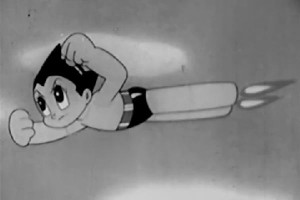Tezuka’s Anime (TV Series)
Osamu Tezuka is well-known as being the “father of Japanese television animation”. When he first decided to try his hand at animation, he quickly realized that, as a small independent studio without the resources of Walt Disney or Toei Animation, the only viable projects would be producing short, simple animation for television commercials; most likely a frustrating and unsatisfying experience. So, instead he decided to do something that had never been tried in Japan – a weekly television anime series.
Understanding that he would be competing with the production costs of live-action television programming, Tezuka made a conscious decision to produce his anime as as a loss-leader on a shoestring budget. This meant he needed to adapt high-quality story concepts to a form of limited animation that required only 10 frames per second or so (as opposed to the standard 24-29) and relied on an image bank of re-usable cells that could be combined and re-combined in new ways to prolong the action sequences.
The process worked, and when the original Black & White Astro Boy (1963-66) television anime first hit the airwaves on Fuji TV on January 1, 1963, it was an instant hit, capturing nearly 40% of the audience. The success allowed Tezuka to build Mushi Productions into a true animation studio that would go on to produce full-colour animated television programs for Jungle Empror (1965-66) and Princess Knight (1967-68), as well experimental animation/live-action hybrid’s shuch as Vampires (1968-69).
Always trying to improve the finished product, Tezuka returned to several of his key series, either as re-imaginings, such as Jetter Mars (1977) or re-makes such as Jungle Emperor (1989-90). In fact, the legacy Tezuka built in regards to television anime has survived his death and Tezuka properties, such as Astro Boy (2003) continue to be developed for the television anime audience to this day.
| Title | Started | Finished | Network | Format | Episodes | Produced by |
| Astro Boy | 01/01/1963 | 21/12/1966 | Fuji TV | B&W | 193 | Mushi Productions |
| Galaxy Boy Troop | 07/04/1963 | 01/04/1965 | NHK | B&W | 92 | Mushi Productions/ Takeda Puppet Theater |
| Big X | 03/08/1964 | 27/09/1965 | TBS | B&W | 59 | Tokyo Movie |
| Wonder 3 | 06/06/1965 | 27/06/1966 | Fuji TV | B&W | 52 | Mushi Productions |
| Jungle Emperor | 06/10/1965 | 28/09/1966 | Fuji TV | Colour | 52 | Mushi Productions |
| Jungle Emperor: Onward, Leo! | 05/10/1966 | 29/03/1967 | Fuji TV | Colour | 26 | Mushi Productions |
| The Adventures of Goku | 07/01/1967 | 30/09/1967 | Fuji TV | Colour | 39 | Mushi Productions |
| Princess Knight | 02/04/1967 | 07/04/1968 | Fuji TV | Colour | 52 | Mushi Productions |
| Vampires | 03/10/1968 | 29/03/1969 | Fuji TV | B&W | 26 | Mushi Productions |
| Dororo | 06/04/1969 | 28/09/1969 | Fuji TV | B&W | 26 | Mushi Productions |
| Marvelous Melmo | 03/10/1971 | 26/03/1972 | Asahi | Colour | 26 | Tezuka Productions |
| Triton of the Sea | 01/04/1972 | 30/09/1972 | Asahi | Colour | 27 | Animation Staff Room |
| Wansa-kun | 02/04/1973 | 24/09/1973 | Kansai TV | Colour | 26 | Mushi Productions |
| Microid S | 07/04/1973 | 06/10/1973 | NET | Colour | 26 | Toei Animation |
| Jetter Mars | 03/02/1977 | 15/09/1977 | Fuji TV | Colour | 27 | Toei Animation |
| Astro Boy | 01/10/1980 | 23/12/1981 | NTV | Colour | 52 | Tezuka Productions |
| Don Dracula | 05/04/1982 | 26/04/1982 | TV Tokyo | Colour | 4 | Sankyo Planning |
| Blue Blink | 07/04/1989 | 16/03/1990 | NHK | Colour | 39 | Tezuka Productions |
| Jungle Emperor | 12/10/1989 | 11/10/1990 | TV Tokyo | Colour | 52 | Tezuka Productions |
| The Three-Eyed One | 18/10/1990 | 26/09/1991 | TV Tokyo | Colour | 48 | Tezuka Productions |
| Bible Stories | 01/04/1997 | 09/05/1997 | NTV | Colour | 26 | Tezuka Productions/RAI |



